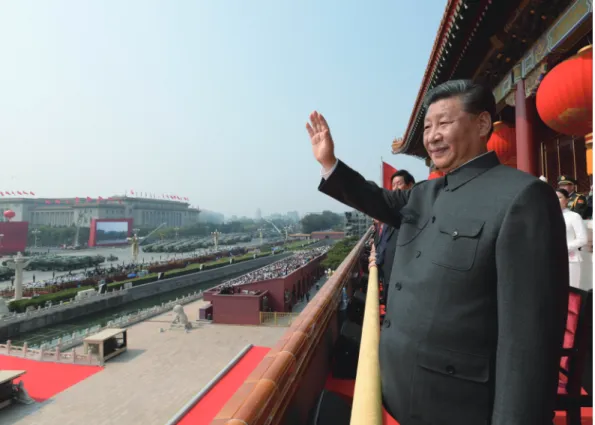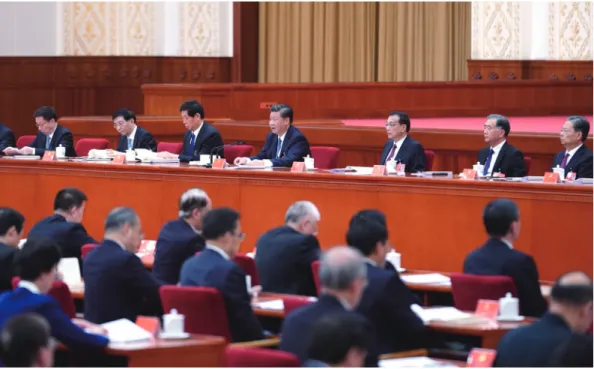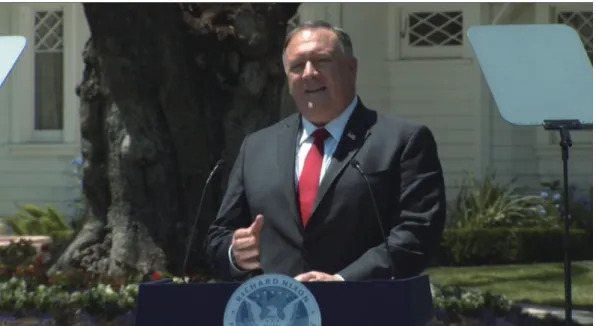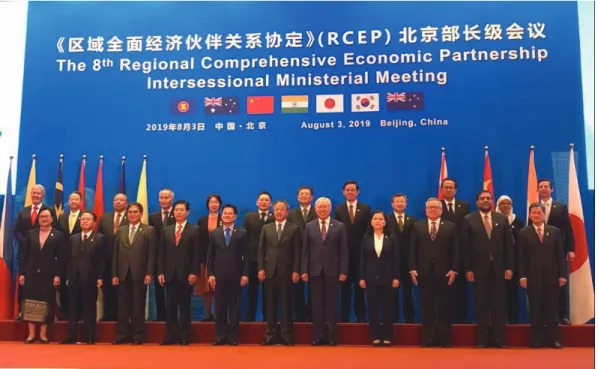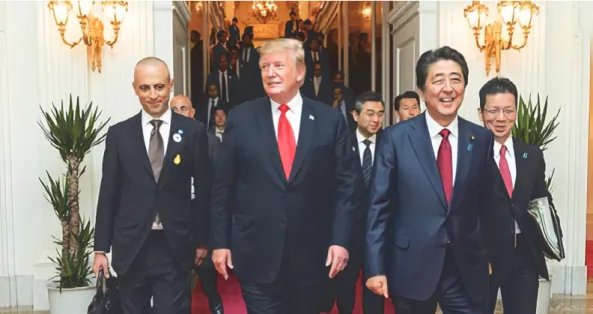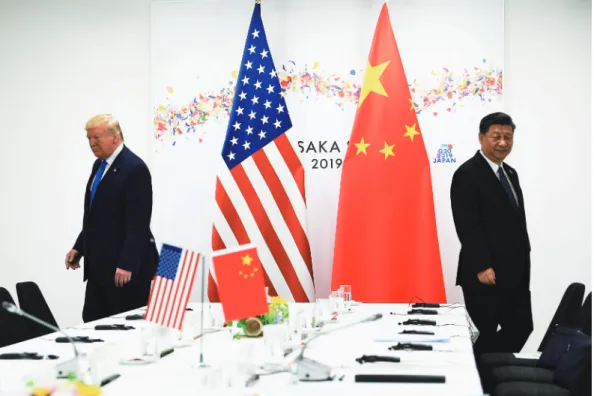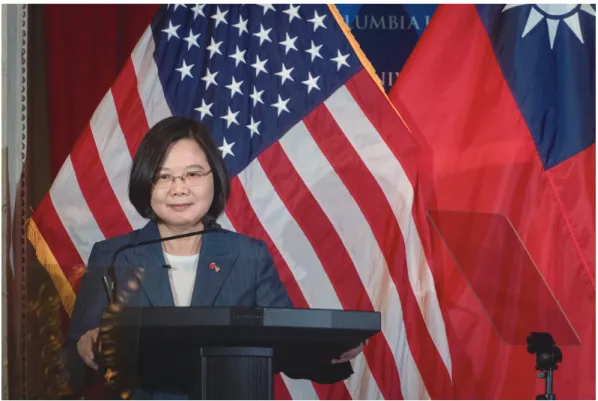The Future Development of U.S.-China
Relations and Indo-Pacific Strategy
Ming-hsien Wong
Director & Professor, Graduate Institute of International Affairs and Strategic Studies, Tamkang UniversityAbstract
This paper addresses the following questions. As Trump was defeated by U.S. President-elect Biden, what are the possible changes to Indo-Pacific strategy: goals, ways, and means? Second, what will happen to the U.S. whole-of-Government approach toward China? What will be Biden’s China policy? Third, under the transformation of U.S. Indo-Pacific Strategy, what are the future China relations and U.S.-Taiwan relations? How should U.S.-Taiwan respond under new phenomena and provide what kind of strategy and policy? Finally, the author notes several important points regarding U.S. Indo-Pacific strategy and U.S.-China relations. First, the U.S. political situation will appear disordered before January 20, 2021, because Trump will not admit defeat in this presidential election. Second, there will a transformation of U.S. Indo-Pacific strategy; basically the new U.S. government will apply a multilateral instead of unilateral approach toward global politics. Finally, the new government will not change the essence of security threats regarding China’s assertive international strategy, but Biden will apply more peaceful and bilateral approaches toward this emerging power.
Keywords: Indo-Pacific Strategy, U.S.-China Relations, U.S.-Taiwan Relations, Strategic
Ambiguity, Strategic Clearness
I. Introduction
1. Outcomes of the U.S. Presidential Election
On November 3, 2020, the U.S. finished the 46thpresidential election. Nevertheless, due to disputes regarding the vote counting system in several states, although Democratic
President candidate Joe Biden apparently won over 270 electoral votes, President Trump has not conceded this outcome and has proposed juridical issues in different states. According to Bloomberg, “The results of last week’s presidential election showed a widening partisan and economic divide between urban and rural America.”1 Also some U.S. radical militia groups, for example Oath Keepers, expressed that they will not recognize President-elect Joe Biden as the next president.2Since the presidential election ended, Trump still has been executing his presidential power according to the regulation of the U.S. Constitution, such as firing Secretary of Defense Mark Esper; announcing on Twitter he was firing Chris Krebs, the director of the Cyber Security and Infrastructure Security Agency under Department of Homeland Security; and releasing an executive order to terminate investment in 31 companies with connection to the People’s Liberation Army, PLA.3
Because “President-elect Joe Biden’s victory in 477 U.S. counties encompasses 70% of America’s economic output, whereas President Donald Trump’s base of 2,497 counties represents less than a third of the economy...” see Reade Pickert, “Economic Divide Between U.S. Political Parties Grew in 2020 Vote,” Bloomberg, November 11, 2020, <https:// www.bloomberg.com/news/articles/2020-11-10/economic-divide-between-u-s-political-parties-grew-in-2020-vote>.
Derek Major, “America’s largest radical militia refused to recognize Joe Biden as president and will resist his administration,” Blackenterprise, November 17, 2020, <https://www. blackenterprise.com/americas-largest-radical-militia-refuses-to-recognize-joe-biden-as-president-and-will-resist-his-administration/>.
Gordon Lubold & Dawn Lim, “Trump Bars Americans from Investing in Firms That Help China’s Military,” The Wall Street Journal, November 12, 2020, <https://www.wsj.com/articles/ trump-bars-americans-from-investing-in-firms-that-help-chinas-military-11605209431>.
Figure 1. Joe Biden and Kamala Harris Won the U.S. Presidential Election Source: Joe Biden, “Let’s Make History,” November 3, 2020, Facebook, <https://m.facebook.
com/joebiden/photos/a.10150487089926104/10157671425871104/? type=3&source=54& ref=page_internal>.
2. Response from the World and Taiwan
At the present time, the U.S. is facing a constitutional crisis, i.e., a lame-duck president and an incoming president together influencing U.S. domestic politics and international affairs. Several important international allies have called and congratulated Biden on being elected as president, but China and Russia have not sent their official congratulations because of uncertainty of future U.S. great power policies.
From Russia’s side, “Biden’s approach to Moscow is far more consistent than Trump’s and is part of his strategy of restoring the U.S.’ global clout.” From China’s side, “We respect the choice of the American people. We extend congratulations to Mr. Biden and Ms. Harris,” a China foreign ministry spokesman said.4
“US election: China congratulates Biden after long silence,” BBC, November 13, 2020, <https:/ /www.bbc.com/news/election-us-2020-54871890>.
Between 2017 and 2020, Trump as U.S. president under the slogan of “America first” via unilateralism has released several internal and international arrangements, such as withdrawal from TPP, Paris Climate Change Accord, and other related agreements. After Trump released his first National Security Strategy Report, he incrementally formulated an Indo-Pacific Strategy to counter China in the Asia-Pacific Region. Henceforth, he has acted under a U.S.-China power competition structure, which will impact not only U.S.-Taiwan relations, but also influence the cross-Strait relationship over the next decade.
3. Research Questions and Arrangement
First, the author analyzes potential factors impacting the future U.S.-China strategic relationship, including the Chinese Dream under Xi Jinping after 2013, and its “14th five year economic plan and goal of 2035.” Second, the author examines Trump’s strategy and policy toward China, especially on March 20, 2020, when the White House released “United States Strategic Approach to the People’s Republic of China,”5and on June 1, 2019, when U.S. Department of Defense released the important Indo-Pacific Strategy Report.6Third, it is essential to compare different China policy orientations between Democrats and Republicans, along with implications toward the future of the Indo-Pacific Region, to examine three possible developments of U.S.-China relations and U.S.-Taiwan interactions after Biden is inaugurated in 2021.
II. Factors Impacting U.S.-China Relations
There have been three main issues impacting U.S.-China power competition since Trump took office: the Chinese Dream under Xi Jinping, the U.S.’ position toward China, and the neighboring Asian countries policy choice between the U.S. and China.
The White House, “United States Strategic Approach to the People’s Republic of China,” March 20, 2020, The White House, <https://www.whitehouse.gov/wp-content/uploads/2020/05/ U.S.-Strategic-Approach-to-The-Peoples-Republic-of-China-Report-5.20.20.pdf>.
The Department of Defense, Indo-Pacific Strategy Report: Preparedness, Partnerships, and
Promoting a Networked Region, June 1, 2019, The Department of Defense, <https://media.
defense.gov/2019/Jul/01/2002152311/-1/-1/1/DEPARTMENT-OF-DEFENSE-INDO-PACIFIC-STRATEGY-REPORT-2019.PDF>.
1. Xi’s Strategic Planning of the Chinese Dream
First of all, China’s rise brought its national comprehensive power and increased its international status, especially when Xi Jinping took power as General Secretary of Chinese Communist Party, CCP, in 2012 and began his grand strategy regarding “Chinese Dream” and “To realize the Chinese dream of great Chinese nation rejuvenation.”
Figure 2. Celebrating the 70th Anniversary of the People’s Republic of China,
Xi Jinping Reviews the Troops
Source: Ministry of National Defense of the PRC,〈慶祝中華人民共和國成立 70 周年大會隆 重舉行〉, October 1, 2019, Ministry of National Defense of the PRC, <http://mod.gov.
cn/big5/shouye/2019-10/01/content_4852011_3.htm>.
On January 23, 2020, the COVID-19 epidemic occurred in Wuhan, which quickly spread out over all Chinese territories and became a global pandemic issue. To counter this virus, Xi released several institutions and regulations, and on June 7, 2020 China released a white paper titled Fighting COVID-19: China in Action. According to this
white paper: “Xi Jinping has taken personal command, planned the response, overseen the general situation and acted decisively, pointing the way forward in the fight against the epidemic.”7
In order to counter the impact of the U.S.-China trade disputes and the implications of COVID-19, Xi has initiated a “dual circulation” strategy, which means “China should rely on a robust cycle of domestic demand and innovation as the main driver of the economy while maintaining foreign markets and investors as a second engine of growth.”8
On October 29, 2020, the Fifth Plenum of the 19th Central Committee of the Communist Party of China had concluded the session also adopted the “CPC Central Committee’s proposals for the formulation of the 14thFive-Year Plan (2021-2025) for National Economic and Social Development and the Long-Range Objectives Through the Year 2035.”9Besides this midterm economic plan, the CCP set the development goal of the PLA in following years, which, according to this plenum, Beijing has set a new goal of turning the PLA into a full-fledged modern military force by 2027.10
“Xinhua Headlines: China publishes white paper on COVID-19 fight,” Xinhua Net, June 7, 2020, <http://www.xinhuanet.com/english/2020-06/07/c_139121660.htm>.
Chris Buckley, “Xi’s Post-Virus Economic Strategy for China Looks Inward,” New York Times, September 7, 2020, <https://www.nytimes.com/2020/09/07/business/china-xi-economy.html>. Wang Cong, Cao Siqi, & Chen Qingqing “China sets ‘pragmatic’ targets through 2035,” Global
Times, October 29, 2020, <https://www.globaltimes.cn/content/1205131.shtml>.
“China plans to complete military modernization by 2027,” November 1, 2020, Guarding India, <https://guardingindia.com/china/china-plans-to-complete-military-modernization-by-2027/>.
Figure 3. The Fifth Plenum of the 19thCentral Committee of
the Communist Party of China
Source:〈第一觀察 讀懂五中全會,這是一個導航密碼〉, Xinhuanet, November 10, 2020,
<http://big5.xinhuanet.com/gate/big5/www.xinhuanet.com/politics/leaders/2020-11/10/ c_1126718542.htm>.
2. Trump’s Strategy and Policy toward China
After Trump was inaugurated as 45thU.S. president, based on his goal of “America First” and his “100-Day Action Plan,” which he called a “Contract with the American Voter,”11he announced withdrawals from several international treaties or organizations, such as TTP, The Paris Agreement, and NAFTA, for the purpose of unilateral achievement of U.S. national interests.
On December 2017, The White House published the first version of Trump’s national security strategy, in which Trump directly highlighted that “China and Russia challenge American power, influence, and interests, attempting to erode American security and prosperity.”12
“Trump’s 100-Day Plan, Annotated: Where His Promises Stand,” April 24, 2017, NPR, <https:/ /www.npr.org/2017/04/24/520159167/trumps-100-day-action-plan-annotated>.
On October 4, 2018, U.S. Vice President Pence made a speech at the Hudson Institute, in which he emphasized “Beijing is employing a whole-of-government approach, using political, economic, and military tools, as well as propaganda, to advance its influence and benefit its interests in the United States.” Pence quoted the first Trump National Security Strategy Report, saying that the U.S. should “seek a relationship grounded in fairness, reciprocity, and respect for sovereignty, and we have taken strong and swift action to achieve that goal.”13
On May 20, 2020, The White House released a white paper titled “United States Strategic Approach to the People’s Republic of China,”14 which stressed that, in addition to Beijing’s rapid economic development, China does not follow the world order. In order to face China’s challenge, the U.S. administration implemented a competitive approach to the PRC.
On July 23, 2020, U.S. Secretary of State Pompeo made a speech titled “Communist China and the Free World’s Future,” where he clearly underscored that “It was to explain the different facets of America’s relationship with China, the massive imbalances in that relationship that have built up over decades, and the Chinese Communist Party’s designs for hegemony.” Pompeo underlined that the U.S. must change its strategy toward China because “We must induce China to change in more creative and assertive ways, because Beijing’s actions threaten our people and our prosperity.”15
p. 2, The White House, <https://www.whitehouse.gov/wp-content/uploads/2017/12/NSS-Fi-nal-12-18-2017-0905.pdf>. The White House, “Remarks by Vice President Pence on the Ad-ministration’s Policy Toward China,” October 4, 2018, The White House, <https://www. whitehouse.gov/briefings-statements/remarks-vice-president-pence-administrations-policy-toward-china/>.
The White House, “United States Strategic Approach to the People’s Republic of China.” Michael R. Pompeo, “Communist China and the Free World’s Future,” July 23, 2020, U.S.
Figure 4. Secretary Michael R. Pompeo Delivers a Speech on China Policy Source: Michael R. Pompeo, “Communist China and the Free World’s Future.”
The executive summary of the “The Elements of the China Challenge,” which was released on November 17, 2020 by the Policy Planning Staff, Office of the Secretary of State, mentioned, “Awareness has been growing in the United States-
and in nations around the world — that the Chinese Communist Party has triggered
a new era of great-power competition.” “Meeting the China challenge requires the United States to return to the fundamentals. To secure freedom, America must refashion its foreign policy in light of ten tasks.”16
3. Response of Main Asia-Pacific Countries
A. International Power Structure
There are two factors impacting future U.S.-China strategic development. First, there is international structure manipulated interaction among nation-states according to Structural Realism. After 2010, when China’s GDP overtook Japan as No. 2 in the world economic development, the issue of “China’s rise” became a reality not only
The Policy Planning Staff, Office of the Secretary of State, “The Elements of the China Challenge,” November 2020, U.S. Department of State, <https://www.state.gov/wp-content/up-loads/2020/11/20-02832-Elements-of-China-Challenge-508.pdf>.
in quantity, but also in quality. In 2013, Beijing released its international development strategy called the “One Belt, One Road” Initiative and built the “Asian Infrastructure Investment Bank,” and “Silk Road Foundation,” completely exposing China’s ambition to dominate the Asia-Pacific economic domain. On November 15, 2020, China and 14 other Asian nations signed “Regional Comprehensive Economic Partnership,” which will become the largest Regional Free Trade Area and will attain much more influence in and around the Indo-Pacific Region.
Figure 5. The 8th Regional Comprehensive Economic Partnership Intersessional
Ministerial Meeting
Source: Wikipedia, “Regional Comprehensive Economic Partnership,” November 27, 2020 Accessed, Wikipedia, <https://zh.wikipedia.org/wiki/%E5%8C%BA%E5%9F%9F%E5% 85%A8%E9%9D%A2%E7%BB%8F%E6%B5%8E%E4%BC%99%E4%BC%B4%E5% 85%B3%E7%B3%BB%E5%8D%8F%E5%AE%9A>.
B. U.S. Lead Deployment of Indo-Pacific Strategy
On June 1, 2019, the U.S. Department of Defense announced Indo-Pacific
Strategy: Report Preparedness, Partnerships, and Promoting a Networked Region,
which underscored that China “seeks to reorder the region to its advantage by leveraging military modernization, influence operations, and predatory economics to coerce other
nations,” and the U.S. will maintain increased investments in these imperatives, which “will sustain American influence in the region to ensure favorable balances of power and safeguard the free and open international order.”17
On November 4, 2019, the U.S. State Department published, A Free and Open
Indo-Pacific: Advancing a Shared Vision.18Based on this report, the U.S. administration is working with allies and partners to implement a shared vision, such as prosperity, regional order, and resource development. Besides this “Advancing a shared Vision” initiative, the U.S. Department of State also created “Blue Dot Network,” which will help participants from the public, private, and civil society sectors in building and financing quality infrastructure projects.19 The other important concept under this Indo-Pacific framework is “The Clean Network,”20in which the U.S. wants to “safeguard the nation’s assets including citizens’ privacy and companies’ most sensitive information from aggressive intrusions by malign actors, such as the Chinese Communist Party.” From the economic and trade sector, the U.S. provided the platform of the annual “Indo-Pacific Business Forum” “that showcased high-impact private-sector investment and government efforts to support market competition, job growth, and high-standard economic development for greater prosperity in the Indo-Pacific.”21
U.S. Department of Defense, The Department of Defense, Indo-Pacific Strategy Report:
Preparedness, Partnerships, and Promoting a Networked Region, June 1, 2019, U.S. Department of Defense,
<https://media.defense.gov/2019/Jul/01/2002152311/-1/-1/1/DEPARTMENT-OF-DEFENSE-INDO-PACIFIC-STRATEGY-REPORT-2019.PDF>.
U.S. Department of State, A FREE AND OPEN INDO-PACIFIC: Advancing a Shared Vision, November 4, 2019, U.S. Department of State, <https://www.state.gov/wp-content/uploads/2019/11/ Free-and-Open-Indo-Pacific-4Nov2019.pdf>.
U.S. Department of State, “Blue Dot Network,” November 22, 2020, Accessed, U.S. Department
of State, <https://www.state.gov/blue-dot-network/>.
U.S. Department of State, “The Clean Network,” November 22, 2020, Accessed, U.S. Department
of State, <https://www.state.gov/the-clean-network/>.
U.S. Department of State, “2020 Pacific Business Forum Promotes Free and Open Indo-Pacific,” October 29, 2020, U.S. Department of State, <https://www.state.gov/2020-indo-pacific-business-forum-promotes-free-and-open-indo-pacific/>.
Figure 6. President Trump and Prime Minister Shinzo Abe, Following Their Meetings on Indo-Pacific Cooperation, May 27, 2019
Source: U.S. Department of State, “A FREE AND OPEN INDO-PACIFIC: Advancing a Shared Vision.”
III. Differences of China Policy between Democrats and Republicans
1. Republican’s Stance toward China
According to the 2020 “Resolution Regarding the Republican Party Platform,” which stated “that the Republican Party has and will continue to enthusiastically support the President’s America-first agenda.”22 This is in line with Trump’s idea where he used “Make America Great Again” as his 2020 campaign slogan.
So, during the 2020 presidential election period, Trump’s administration maintained its agenda of Indo-Pacific strategy. The main goal of Trump’s Indo-Pacific strategy utilizes a multilateral approach under U.S. leadership to contain China in this region. To a certain degree, the related countries in the Indo-Pacific region are facing a security dilemma, i.e., they will not simply side with China or the U.S., but most of them will use their individual national interest to cope with Beijing or Washington.
Republican Party National Committee, “Resolution Regarding The Republican Party Platform,” August 24, 2020, The American Presidency Project, <https://www.presidency.ucsb.edu/documents/ resolution-regarding-the-republican-party-platform>.
2. Democrat’s China’s Policy
On July 27, 2020, according to “2020 Democratic Party Platform,” which emphasized that the U.S., as a Pacific power “should work closely with its allies and partners to advance our shared prosperity, security, and values—and shape the unfolding
Pacific Century.”23 Regarding the China issue, Biden said his approach will “focus on boosting American competitiveness, revitalizing our strengths at home, and renewing our alliances and leadership abroad.”24 In other words, Biden said the U.S. would work to cooperate with China when it is in the U.S. national interest, such as on public health and climate change.
Figure 7. Joe Biden with Children Supporters
Source: Joe Biden, “Joe Biden with Children Supporters,” July 27, 2016, Facebook, <https://m. facebook.com/joebiden/photos/a.10150618068541104/10153595289756104/?type=3& source=54&ref=page_internal>.
“Democrats’ approach to China will be guided by America’s national interests and the interests of our allies, and draw on the sources of American strength—the openness of our society, the
dynamism of our economy, and the power of our alliances to shape and enforce international norms that reflect our values,” see Democratic Party, “2020 Democratic Party Platform,” July 27, 2020, p. 88, Democratic Party, <https://www.demconvention.com/wp-content/uplo-ads/2020/08/2020-07-31-Democratic-Party-Platform-For-Distribution.pdf>.
3. Comparison of Two Parties’ China Policy
According to the Republican Platform and under the slogans of “America First” and “American Great Again,” Trump’s China policy exposed not only a unilateral approach, but also much more coercive posture. Trump also applied a collective structure of Indo-Pacific Strategy in order to influence Asia-Pacific nations in jointly engaging an emerging Communist China. On the contrary, the Democratic Party under Biden will follow the Obama administration’s soft approach, especially its multilateral way to engage a rising China. In sum, both parties recognize that China has changed its modest national security strategy into more assertive posture, but they differ in how to effectively engage this emerging China, so both parties share the same consensus with different approaches and means.
IV. Future U.S.-China Development Scenarios
1. A New Cold War between the U.S. and China
Under the first scenario, the U.S. will prolong its strategic competition with China, i.e., according to the Trump administration’s China policy and guidelines to coerce China not only in the regional dimension, but also throughout global aspects. The U.S. government will keep the three decoupling policy, including military, economic, and political aspects. According to this scenario, Taiwan can be a very important card or a leverage chip against China. Washington will, via Taiwan Relations
Act, provide more offensive weaponry to Taipei in order to enhance Taiwan’s defensive
capabilities.
Matthew Mazzetta, “Biden vows deeper ties with Taiwan in new op-ed,” Focus Taiwan, October 22, 2020, <https://focustaiwan.tw/politics/202010220014>.
Figure 8. Donald Trump and Xi Jinping at 2019 G20 Summit
Source:胡玉立, 〈鷹派主導 美中關係步步瓦解 分析:目標是全面性競爭〉, World Journal,
July 25, 2020, <https://www.worldjournal.com/wj/story/121469/4731540? from=wj_referralnews>.
2. Limit Compromise and Control Disputes between U.S. and China
Even after Biden takes office in 2021, the U.S. image of China’s threats has bipartisan consensus, so Washington cannot change this confrontation in a short period, but will use a de-escalate approach toward China. In global issues, such as UN, Climate Change, and global economic disputes, the U.S. will pursue a much tenderer stance in order to widen U.S.-China opportunities of cooperation. In military aspects, especially in the First Island Chain within the South China Sea, the U.S. administration will decrease its military exercises in this area and booster mutual strategic dialogue in this regard.
3. U.S.-China Comprehensive Cooperation in Asia-Pacific
The previous Democratic administration under Obama released its Pivot to Asia initiative in 2011 and initiated the “New Model of great Power relations” during Xi
Jinping’s 2013 state visit to the U.S. On September 20, 2013, China’s Minister of Foreign Affairs Wang Yi delivered a speech in Brookings on the state of U.S.-China relations and quoted Chinese President Xi Jinping’s vision regarding U.S.-China new model relations, including “no conflict or confrontation,” “mutual respect,” and “win-win cooperation.” This answers the first question.25Just like October 11, 2011, when former Secretary of State Hillary Clinton announced an important paper titled “America’s Pacific Century,” in which she indicated “six key lines of action: strengthening bilateral security alliances; deepening our working relationships with emerging powers, including with China; engaging with regional multilateral institutions; expanding trade and investment; forging a broad-based military presence; and advancing democracy and human rights.”26 Both Beijing and Washington have created several frameworks of dialogues, such as Security and Strategic Dialogue and Economic Dialogue, which will be a guideline for a future U.S.-China comprehensive relations.
V. Conclusion: Future Development of U.S.-Taiwan Relations?
1. Review of Strategic Environment in 2021
From November 3, 2020 until January 19, 2021 is a period of uncertainty because the U.S. is facing a lame-duck president while awaiting a new president. Trump can still direct the White House and release different executive orders without approval by Congress. Also, according Trump’s essence of decision-making process he will still promote an anti-globalization posture and anti-China policy, which will impact international politics after 2021.
2. Mutual Policy and Action between U.S. and China
Second, if Biden successfully is inaugurated the 46thU.S. president, the highest priority task for him is to reconcile domestic affairs, such as economic development, social disorder, and racial discrimination, but above all to resolve the COVID-19
“Wang Yi: Toward a New Model of Major-Country Relations Between China and the United States,” September 20, 2013, Brookings, <https://www.brookings.edu/on-the-record/wang-yi-toward-a-new-model-of-major-country-relations-between-china-and-the-united-states/>.
Hillary Clinton, “America’s Pacific Century,” Foreign Policy, October 11, 2011, <https:// foreignpolicy.com/2011/10/11/americas-pacific-century/>.
problem within whole U.S. From the international dimension, U.S. President Biden first must rebuild the confidence-building measures with allies and partners and reenter some important international organizations and global regimes, such as the World Health Organization and Paris Climate Change Accord, in order to engage a rising assertive China in the Asia-Pacific Region.
Furthermore, in the future, U.S. arms sales to Taiwan will return to the level during Obama’s administration. This means that U.S.-Taiwan military ties will relative moderate and become more passive to not enhance disputes between China and the U.S. From the economic aspect, President Tsai already has agreed to import U.S. beef and pork, which will lead to U.S.-Taiwan economic negotiation regarding a Bilateral Trade Agreement, BTA. After the U.S. Congress approved several acts in 2018, such as Taiwan Travel Act and Taiwan Allies International Protection and Enhancement
Initiative Act 2019, the U.S. will pursuit more of a multilateral approach to re-engage
China.
To the U.S.’ cross-Strait policy, Biden will go back to the previous U.S. strategic ambiguity approach toward Taiwan, which means the U.S. side will not clearly help Taiwan with military means against the PLA when Taiwan faces China’s aggressive and military invasion. On the contrary, PLA will conduct its military exercises via air and marine forces surrounding Taiwan’s air identification zone, in order to fulfill China’s two strategic goals: one is to train the PLA forces to gain real-time combat capabilities, the other is related political motives to coerce Taiwan to accept the “1992 consensus” under the one China principal, to force Taipei accept reunification negotiations.
Figure 9. President Tsai Attends Discussion Session at Columbia University Source: Office of the President, Taiwan (R.O.C.), “President Tsai attends discussion session at
Columbia University,” July 13, 2019, Office of the President, Taiwan (R.O.C.), <https:// english.president.gov.tw/NEWS/5776>.
3. Taiwan’s Rebalance of Strategic Thinking
Under this new U.S.-China strategic interaction, Taiwan must apply “Strategic balance and diplomacy with same distance,” i.e., Taiwan must keep continuing contact with U.S. think tanks, to collect more information regarding Biden’s China Policy planning. What will the U.S.’ future strategic planning against China? The U.S. will apply a military decoupling strategy but economic coupling policy. What if the U.S. changes its one China policy? What would be the implications toward U.S.-Taiwan relations? On the other side, Taiwan should comprehend how to reengage with China more strategically.
Since China has made its future national development plan until 2035, from Beijing’s side, how to maintain internal stability is the upmost important goal. Nevertheless, China will not allow any delay of the reunification process. Consequently,
Taiwan must first reach a consensus internally regarding independence or unification with Beijing. That is, Taiwan must prepare to negotiate with China not only with a soft power approach, but also via hard power means to back up future cross-Strait developments in order to gain more chips for Taipei.
Finally, on October 22, Democratic presidential candidate Joe Biden pledged to deepen ties with Taiwan in an op-ed in America’s largest Chinese-language newspaper.27Taiwan must realize under newly emerging U.S.-China interaction, Taipei has opportunity to enhance Cross-Strait relations, deepen the U.S.-Taiwan strategic relationship, but also present Taiwan’s will be stable and to provide its regional contribution for the whole Asia-Pacific region.

